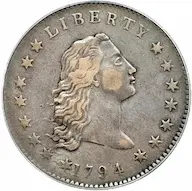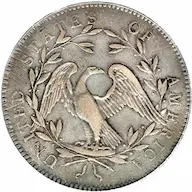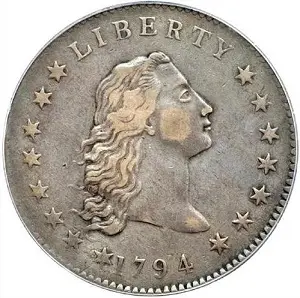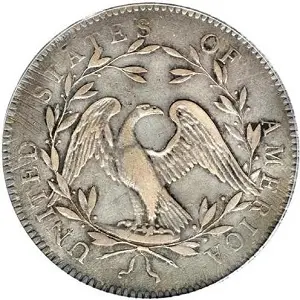1794 Flowing Hair Dollar
The Mint Act of April 2, 1792, established the United States Mint and a bimetallic coinage system based on the silver dollar and the gold eagle as the primary monetary units of the nation, with all other coin denominations being either a fraction or a multiple of these two units.(1)
In the early years of the Mint, there was no fund to purchase silver (or gold). Instead, the Mint obtained silver through deposits from the public. Usually, this came in the form of foreign coins or raw silver, but kitchen utensils or other wrought items were accepted as well. After a delay of some days, depositors received new coins converted from their silver contribution.(2)
On October 15, 1794, circumstances were finally aligned to begin striking the flagship silver coin of the fledgling nation: the U.S. dollar. Mint Director David Rittenhouse provided the silver for the momentous occasion.
The best available machine was a manually powered screw press designed to strike cents and half dollars. Unfortunately, it did not generate enough power to consistently produce sharp details on the dollar-sized coin. Of the 2000 dollars struck that day, 242 were outright rejected because of strike weakness, leaving a net 1,758 mintage of the 1794 Flowing Hair dollar.
Most of the “keepers” were not well struck either, a situation exacerbated when the dies shifted slightly during the production run and lost their parallel relationship, causing concentrated weakness on the left side of the obverse and corresponding area on the reverse.
Researchers have uncovered documents indicating the original plan was to strike many more 1794 dollars, but production was halted out of disappointment in the results. No more silver dollars were produced until a larger press could be installed, which happened in the spring of 1795.
Rittenhouse took possession of the entire lot of 1794 dollars. Understanding the importance of the first United States dollar type, he carefully preserved at least one example and distributed a few others to well-placed individuals, but the vast majority eventually reached general circulation.(3)
Because of the 1794 Flowing Hair dollar’s significance, it has been in the spotlight since coin collecting gained traction in the 1850’s. Examples that might have been lost in the melting pot were instead set aside, regardless of their condition. While there are only about 150 known examples today, the coin’s early popularity may explain the relatively high survivorship rate of 8.5%.(4)
Today, the 1794 Flowing Hair dollar is celebrated as one of the greatest coins not just in American numismatics, but in the entire world. Not simply because of its rarity, but because of its historic standing as the first representative of the basic monetary unit of the newly established republic called the United States of America.
Take note: The 1794 Flowing Hair dollar is ranked #3 in the fine publication 100 Greatest U.S. Coins. The only coins to rank higher are the 1804 Draped Bust dollar (virtually uncollectible) and the 1849 Liberty Head double eagle (unique specimen, permanently held at the Smithsonian).(5)
| Estimated survivors in all grades: 150 ?
The survivor estimate from PCGS represents an average of one or more experts' opinions as to how many examples survive of a particular coin in all grades. Survival estimates include coins that are raw, certified by PCGS, and certified by other grading services. Learn more at PCGS. |
| PCGS Rarity Scale: 7.5 ?
The 'PCGS CoinFacts Rarity Scale' assesses the relative rarity of all U.S. coins, based on estimated surviving examples. The scale runs from 1.0 to 10.0. The higher the number, the rarer the coin.
Learn more at PCGS. |
| Search for the 1794 Flowing Hair Dollar on eBay** |
Preview of eBay selection (one of the rarest, most prized coins in numismatics, seldom does a 1794 dollar appear for sale -- be sure to also try the Search link above):
 |
 |
| Trendline Avg = 30.21 | BEST |
 |
 |
| Trendline Avg = 30.21 | BEST |
Historic Value Trend Charts:
| Last updated 6-9-25 | Return to Key Date Coin List | |
| Compare to Common Date Coin of Same Type | ||
|
|
||
| Download Charts to Your Computer | ||
Sources
1. Garrett, Jeff and Guth, Ron. 100 Greatest U.S. Coins, 5th ed. Pelham, AL: Whitman Publishing, 2019.
2. PCGS. 1794 $1 (Regular Strike).
3. Stack's Bowers Galleries. 1794 Flowing Hair Silver Dollar. Sep 2015 Auction.
4. PCGS. 1794 $1 (Regular Strike).
5. Garrett, Jeff and Guth, Ron. 100 Greatest U.S. Coins, 5th ed. Pelham, AL: Whitman Publishing, 2019.
**Many very fine coin dealers sell on eBay. At any point in time, there may be over one million search results for United States coins. This includes quite a few of the recommendations on our Key Date Coin List.
If you’re thinking about purchasing a rare coin, eBay is certainly worth a look. For your convenience, the links from this site to eBay are coded to bring up only coins certified by PCGS and NGC.
As is always, always the case, never buy a valuable coin from a seller whose trustworthiness cannot be verified. Learn more about this at our chapter Best Places to Buy Coins, which also has a section on doing business on eBay.
In the interest of full disclosure, Rare Coins 101 receives a small commission anytime someone connects to eBay from this site and purchases something.
Coin images by Stack's Bowers Galleries.


